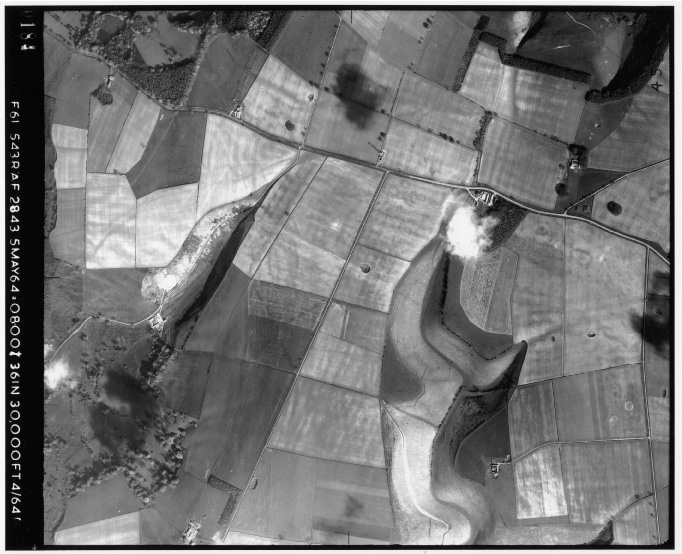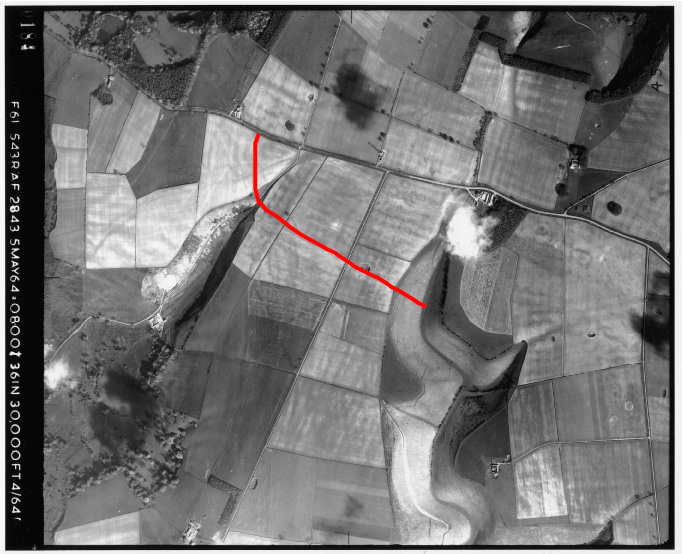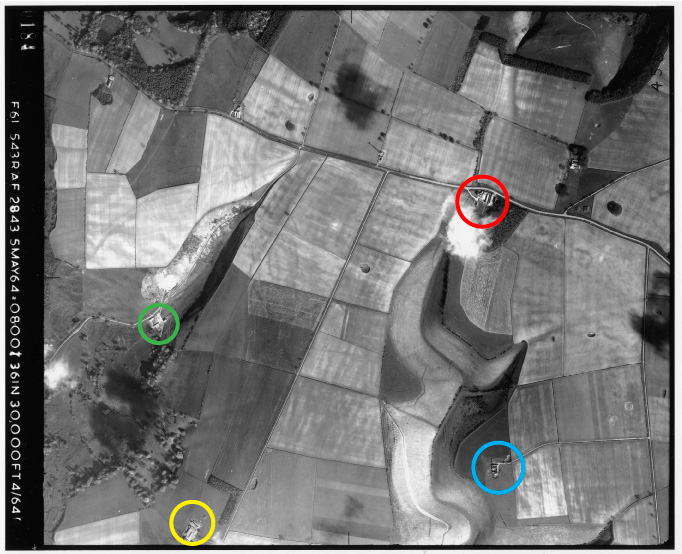
An Aerial View of the Wolds
By Mike Pratt
previous item | up | next item
The name of this section of the website is "History on the Ground" and in the main it is taken to mean the history that can be found by walking about & looking around. However, we cannot ignore the usefulness of aerial photographs in our searches, especially as they can provide evidence from the air of features we would not be able to spot otherwise. On this page we use one aerial photograph to highlight features which been levelled in the landscape by the acts of man.
The parish of Bishop Wilton encloses a small part of the Yorkshire Wolds that nevertheless provides ample evidence of its past. This is a past that can be missed when passing along its roads, between fields of relatively recent introduction. An almost eradicated past that is both recent and prehistoric.

An Aerial Photograph - The road out of the village of Bishop Wilton rises up through Worsendale on the left (the West) of this photograph (starting about one third of the way up). It gets to the head of the dale and then joins the A166 at a T junction. The A166 (which acts as the Northern boundary of the parish) continues on East, past Cot Nab Farm which can be seen just North of a cloud that obscures the head of another dale, Deepdale. Half way between the Worsendale Road and Cot Nob there is a road going South in a perfectly straight line that is known to this day as Beacon Road. Just before the A166 leaves the right hand side of the photograph (in the East), there is another road South, which is known as The Bence possibly because of the extant prehistoric banks and ditches it passes on its way.

An Ancient Trackway - As you walk out of the village of Bishop Wilton up Worsendale Road you eventually come to buildings on the right which started out life as Beechwood Farm (see "Four Wolds Farms" below) in the early 1800s. Opposite these buildings is a gate from which a trackway rises which eventually reaches the Wold top. It is suggested that this is an ancient trackway that existed before the current road that continues on up to the head of the dale past former chalk quarries. Its route can still be seen on the ground in this aerial photograph. The red marking traces this route all the way to Cot Nab farm (partly obscured by a cloud). The trackway continues on, past Cot Nab, but it is not marked as its route is not too clear on this photo although it can be seen on others. At least part of the route of this possible trackway is identified by J. R. Mortimer (see next item for more information on him).

A Wolds Land Division - The Wolds in general are criss-crossed by prehistoric earthworks of banks and ditches. Typically they travel from the head of one dale to the head of another. The earthwork banks traced out here are unusual in that they traverse this area of the Wolds and cut across two dales (Worsendale on the left and Deepdale on the right) going down the sides and up again. Prehistoric in nature, these earthworks are described as being Iron Age land divisions.
J. R. Mortimer in his book entitled "Forty Years' Researches in British and Saxon Burial Mounds of East Yorkshire" (published in 1905) represents this feature on a "Plan of the Entrenchments and Barrows on a section of the Yorkshire Wolds" (a folding map preceding page 1). The key to Mortimer's plan types the earthwork as a single entrenchment leading into a double entrenchment. It is worth recognising here that Mortimer was describing what he saw on the ground. It would appear that he confuses the land division with the ancient trackway at its Western end whereas aerial photographs show these to be two separate features, one crossing the other at right angles. The section of the earthwork between Worsendale and Deepdale is strikingly shown on the aerial view of the current (August 2011) Bing Map for the area. It shows the dark lines of the remains of three trenches, quite impressive, as continuous ploughing has completely levelled the length of the earthwork making it invisible from the ground.

Four Wolds Farms - Four post-enclosure farms (post 1772) are ringed here mainly to identify Manna Green which is ringed in blue and now removed from the landscape. The farm house & buildings have been knocked down and the land has been absorbed elsewhere. Beechwood Farm, ringed in green is now a private residence. The other two are Cot Nab (red) and Wilton Wold (yellow). Cot Nab has prehistoric linear earthworks in its grounds (not visible to the public) for which more information is provided here.
![]()
Wilton Beacon (in the centre of the yellow square) - According to Poulson in his "History of Holderness" Wilton beacon was established in 1588 at the time of the Spanish Armada, as part of the 'early warning system' to alert the armed militia to the arrival of the enemy. It is very likely that the Romans had a beacon there too. It was revived in the early 1800s because of fear of a French invasion. "Two watchers named Gray and Black lived in the hut made of sods, which stood near the base of the beacon." ('The Beacons of East Yorkshire' John Nicholson, 1887, quoted by Andrew Sefton in Local History Bulletin 9, 2004)
Mortimer (see reference in "A Wolds Land Division" above) says that it was built on a pre-historic barrow, as the highest point - 780 feet (237 metres) above sea level. In excavating the barrow, parts of the wooden foundations of the beacon were unearthed, but that was all that remained by then - apart from the names of Beacon Field and the nearby Beacon Road. The beacon consisted of a sturdy upright post with pegs projecting from the sides to climb up, with an iron cage on the top in which the tar-barrel would be placed to be lit. The system was that Wilton 'took light' from Bainton, Hunsley and Rudston and 'gave light' to Holme-on-Spalding-Moor and the Vale of York.
The reference for the aerial photograph used above is 543/2843 F61 FR:0184. It was taken on 5th May 1964.
It is made available under the following licence:
http://www.nationalarchives.gov.uk/doc/open-government-licence/
(c) Copyright 2009 Contributors. All rights reserved. |